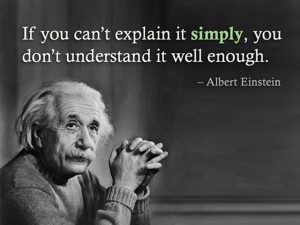Research reports are a cornucopia of complicated statistical representations. Or, if I may say in simpler terms, a lot of fancy numbers.
Research reports are a cornucopia of complicated statistical representations. Or, if I may say in simpler terms, a lot of fancy numbers. As researchers, we get so engrossed in the statistical analyses, visual representations, and factual reporting that we forget how our experience with research and statistics differs from the experiences of other 
We forget that our readers may not have take years of statistics and research methods class and therefore don’t always understand how statistics work, why sample size matters, why effect size matters, or even what these terms mean. We forget that our world is very different from the world of a brand manager, a marketer, a consumer, a CEO. We speak in researchese not peoplese.
With that in mind, consider these excellent and accurate definitions of a t-test.
- A t-test is any statistical hypothesis test in which the test statistic follows a Student’s t distribution if the null hypothesis is supported.
- A statistical examination of two population means. A two-sample t-test examines whether two samples are different and is commonly used when the variances of two normal distributions are unknown and when an experiment uses a small sample size.
- In statistics, a t-test is what the distribution will be if a student’s null hypothesis is true. The usual form for t-test statistics is T=Zls.
- The t–test is a simple test of the separation of two sets of data, and is used to determine significance of experimental results.
- The t-test tells you if the average number for one group is different from the average number for another group. (e.g., the average height of women vs the average height of men)
So tell me, which definition made the most sense to you? I’m going to guess it’s option number 5. This is the only option that avoided standard statistical terms and brought the language into the sphere of a regular person in the regular world. Most people should feel confident in their ability to share that information with other people no matter what their experience with statistics is.
The researcher’s goal is to share information, to communicate clearly, and to help other people understand what we are saying. So my suggestion to you is this.
Speak simply. Write simply. Be understood.